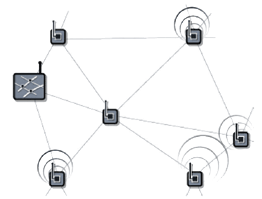Wireless Sensor Networks
Wireless sensor networks consist of a large number of sensor nodes that may be randomly placed without the need of structure and wires of any kind. Sensor nodes are small devices with processing capabilities that may be attached to sensors in the environment, or contain sensors of their own. These devices then communicate this data, typically to a centralized unit or to each other along a route to this unit. The advantages of such networks are increased mobility, reduced installation and maintenance costs, and increased range of use.

The above exerpt from Evaluation of SmartMesh-XR - Wireless Multihop Network, provides a short description of wireless sensor networks (WSNs). To fully understand the basics and key concepts of WSNs I would recommend reading the second chapter of this document. Readers that are eager to learn even more can continue with the following chapters for a detailed theoretical study of SmartMesh-XR and competing protocols like Wavenis and SensiNet. The theory is then followed by chapters that documents hands-on experiments performed in both industrial and non-industrial environments. Note the picture beside this section showing a SmartMesh-XR network connected in mesh topology.
Though WSNs are both facinating and exciting, lots of applications do not require the power and reliability of such communication. In fact, the majority of wireless applications will do just fine with cheap single-chip trancievers for the world wide 2.4 - 2.5 GHz band. There are a great many providers of radio trancievers, and I've personally only tested a few from companies like Nordic Semiconductors and Texas Instruments (or Chipcon as the company was named before it got acquired by TI in early 2006). The latter has a tranciever family named CC while Nordic has a nice series starting with the letters nRF. I have used the nRF2401 in several projects and can easily recommend it due to nice pricing and ease of use. Visit their websites for more documentation, or send me an email if you have a specific question.
SmartMesh-XR

Learn about SmartMesh-XR and competing WSNs in Evaluation of SmartMesh-XR. The document is in english and is actually my master thesis from the Norwegian University of Science and Technology (NTNU) in Trondheim, 2006.
ZigBee

Learn about ZigBee and the IEEE 802.15.4 standard in Wireless HART using ZigBee. The document is in norwegian and was written to document my pre-master project at NTNU in Trondheim, 2005.
Radio Trancievers

Trying to figure out what radio tranciever to use in your application? Visit Nordic Semiconductors and Texas Instruments for cheap single-chip trancievers along with documentation and programming notes. I intended to upload my bachelor assignment from HIVE in Tønsberg (2004) for this purpose, but it turns out that the document is confidential due to NDA.